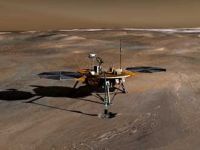 Yesterday’s launch of the asteroid-bound Dawn Mission was postponed until September due to bad weather and potential interference with the scheduled launch of the Mars Phoenix Lander on August 8th.NASA has scheduled a news conference for later today to discuss aspects of the postponement and the Phoenix program. Prior to the Phoenix presentations, media will have the opportunity to learn in more detail about the rescheduled Dawn launch.
Yesterday’s launch of the asteroid-bound Dawn Mission was postponed until September due to bad weather and potential interference with the scheduled launch of the Mars Phoenix Lander on August 8th.NASA has scheduled a news conference for later today to discuss aspects of the postponement and the Phoenix program. Prior to the Phoenix presentations, media will have the opportunity to learn in more detail about the rescheduled Dawn launch.
Image left: Artist’s concept of Phoenix on the surface of Mars. Image credit: NASA/JPL.
The Phoenix Lander is the first in a series of landers in NASA’s Mars Scout Program. The “Phoenix” name is taken as the lander is a reincarnation of previous landers or failed missions. Phoenix will land in the icy Northern Plains of Mars and become a fixed-location probe designed to explore the geological history of that region of the planet.
Read more about the Phoenix Lander Program and watch the really cool NASA animated video of the arrival of Phoenix on Mars:
NASA’s Phoenix Mars Mission Gets Thumbs Up for 2007 Launch
NASA has given the green light to a project to put a long-armed lander onto the icy ground of the far-northern martian plains. NASA’s Phoenix lander is designed to examine the site for potential habitats for water ice and to look for possible indicators of life, past or present.
NASA Video – click > to play.Today’s announcement allows the Phoenix mission to proceed with preparing the spacecraft for launch in August 2007. This major milestone followed a critical review of the project’s planning progress and preliminary design since its selection in 2003.
Phoenix is the first project in NASA’s Mars Scout Program of competitively selected missions. Scouts are innovative and relatively low-cost complements to the core missions of the agency’s Mars exploration program.
“The Phoenix Mission explores new territory in the northern plains of Mars analogous to the permafrost regions on Earth,” said the project’s principal investigator, Dr. Peter Smith of the University of Arizona, Tucson. “NASA’s confirmation supports this project and may eventually lead to discoveries relating to life on our neighboring planet.”
Phoenix is a stationary lander. It has a robotic arm to dig down to the martian ice layer and deliver samples to sophisticated analytical instruments on the lander’s deck. It is specifically designed to measure volatiles, such as water and organic molecules, in the northern polar region of Mars. In 2002, NASA’s Mars Odyssey orbiter found evidence of ice-rich soil very near the surface in the arctic regions.
Like its namesake, Phoenix rises from ashes, carrying the legacies of two earlier attempts to explore Mars. The 2001 Mars Surveyor lander, administratively mothballed in 2000, is being resurrected for Phoenix. Many of the scientific instruments for Phoenix were built or designed for that mission or the unsuccessful Mars Polar Lander in 1999.
“The Phoenix team’s quick response to the Odyssey discoveries and the cost-saving adaptation of earlier missions’ technology are just the kind of flexibility the Mars Scout Program seeks to elicit,” said NASA’s Mars Exploration Program Director, Doug McCuistion.
“Phoenix revives pieces of past missions in order to take NASA’s Mars exploration into an exciting future,” said NASA’s Director, Solar System Division, Science Mission Directorate, Dr. Andrew Dantzler.
The cost of the Phoenix mission is $386 million, which includes the cost of launch. The partnership developing the Phoenix mission includes the University of Arizona; NASA’s Jet Propulsion Laboratory, Pasadena, Calif.; Lockheed Martin Space Systems, Denver; and the Canadian Space Agency, which is providing weather-monitoring instruments.
“The confirmation review is an important step for all major NASA missions,” said JPL’s Barry Goldstein, project manager for Phoenix. “This approval essentially confirms NASA’s confidence that the spacecraft and science instruments will be successfully built and launched, and that once the lander is on Mars, the science objectives can be successfully achieved.”
Much work lies ahead. Team members will assemble and test every subsystem on the spacecraft and science payload to show they comply with design requirements. Other tasks include selecting a landing site, which should be aided by data provided by the Mars Reconnaissance Orbiter launching in August, and preparing to operate the spacecraft after launch.
